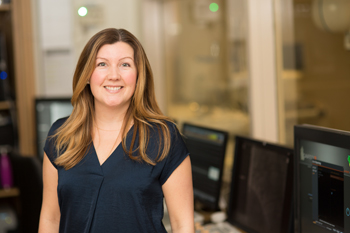Q&A with Emily Little

By Leslie Shepherd and Emily Holton

Emily Little, Case Manager and Device Triage Co-ordinator, Arrhythmia Service (Photo by Yuri Markarov)
Q. Tell us about your job. How do you care for Heart and Vascular patients?
I have a unique role that is dynamic and highly rewarding. I have developed a one-stop shopping philosophy for patients who have or are receiving a pacemaker or implantable cardioverter defibrillator, as I am their point person throughout their journey at St. Michael’s.
After their consultation with an electrophysiology (EP) physician, I meet the patients to do their pre-admission assessment and testing on the same visit. It saves patients from having to come back for multiple pre-op visits and helps ease anxiety, as they leave knowing the care plan. I talk with the patient and his or her family about how to prepare and what to expect during the implant procedure. I give them a pre-op folder complete with educational material, instructions and directions for the day of their procedure and my contact information. I complete a nursing assessment and anesthesia screening, arrange any tests and bloodwork, then follow up with the results in collaboration with the EP physicians. These nursing assessments allow me to triage and arrange the procedure date based on the type of procedure, battery life of the device and availability of family support. Following the procedure, I see every patient to review his or her discharge teaching, incision care instructions and followup appointment and answer any questions he or she may have about living with his or her device.
Q. What drew you to this job?
I started at St. Michael’s as a McMaster University student in the nursing mentorship program and found my passion in the heart and vascular post-surgical patient population. I took a year off from St. Michael’s and moved to Australia where I got my nursing license and worked at various nursing jobs while traveling around the country. Once back at St. Michael’s, I was eager for another challenge and was given the opportunity to join the Arrhythmia Service. The case management role combined my enthusiasm for patient education and strong organizational and triaging skills, with the desire to offer patient-centred care and support for patients undergoing a device implant.
In 2015, I graduated from Ryerson University’s master of nursing program. The knowledge and leadership strategies I gained from the program have been pivotal to my professional growth within the case management role.
Q. Tell us more about the Arrhythmia Service.
In January 2015, EP device implants moved up to the Cath Lab from the main OR. This was a challenging move as so many aspects and processes needed to change, and, with any major change, there were many growing pains along the way. However, the integration of the procedure types and populations provided strong collaborative opportunities for the Cath Lab and EP teams, specifically surrounding resource management and communication, while delivering patient-centred interactions. My role grew again as I was meeting new people, fostering strong and trusting working relationships, acting as a resource and educator, and developing new patient education material and procedure practices in our new home in the Cath Lab.
The Electrophysiology Service is a multidisciplinary team that cares for patients with heart rhythm disorders, including implanted cardiac devices. We implant approximately 540 cardioverter defibrillators, pacemakers and loop recorders each fiscal year. The batteries in these devices vary, lasting about seven to 12 years, so I am now seeing patients who remember me from their original implant. Recently, one of our patients who needed to upgrade his device because of heart failure symptoms excitedly showed me my old business card from 2007 when I came for his pre-op assessment. He had kept it all this time, just in case he had a question! Other patients have shown their appreciation by making a donation to the St. Michael’s Hospital Foundation in my name, writing me personal thank you cards, or asking to see me at their followup appointments. Each of these gestures truly warms my heart and reminds me of the difference I make to their patient experience.
Q. Did you always want to be a nurse?
In high school, I was strong in sciences and my guidance counselor suggested I apply to schools for a bachelor of science in nursing. Once at McMaster University, I excelled in biochemistry and found the Anatomy Lab fascinating, quickly realizing that I had found my purpose. In second year, I was excited to start hospital placements. I quickly discovered that I have a strong aversion to phlegm. I was standing at the end of a patient’s bed when they coughed and a huge bit of phlegm flew in the air and landed on the front of my hospital scrubs. I fainted. Passed right out cold! I was so embarrassed and I thought my days of becoming a nurse where over before they had began. But I stuck with it and can’t imagine my life in any other profession.
About St. Michael’s Hospital
St. Michael’s Hospital provides compassionate care to all who enter its doors. The hospital also provides outstanding medical education to future health care professionals in more than 29 academic disciplines. Critical care and trauma, heart disease, neurosurgery, diabetes, cancer care, care of the homeless and global health are among the Hospital’s recognized areas of expertise. Through the Keenan Research Centre and the Li Ka Shing International Healthcare Education Centre, which make up the Li Ka Shing Knowledge Institute, research and education at St. Michael’s Hospital are recognized and make an impact around the world. Founded in 1892, the hospital is fully affiliated with the University of Toronto.
